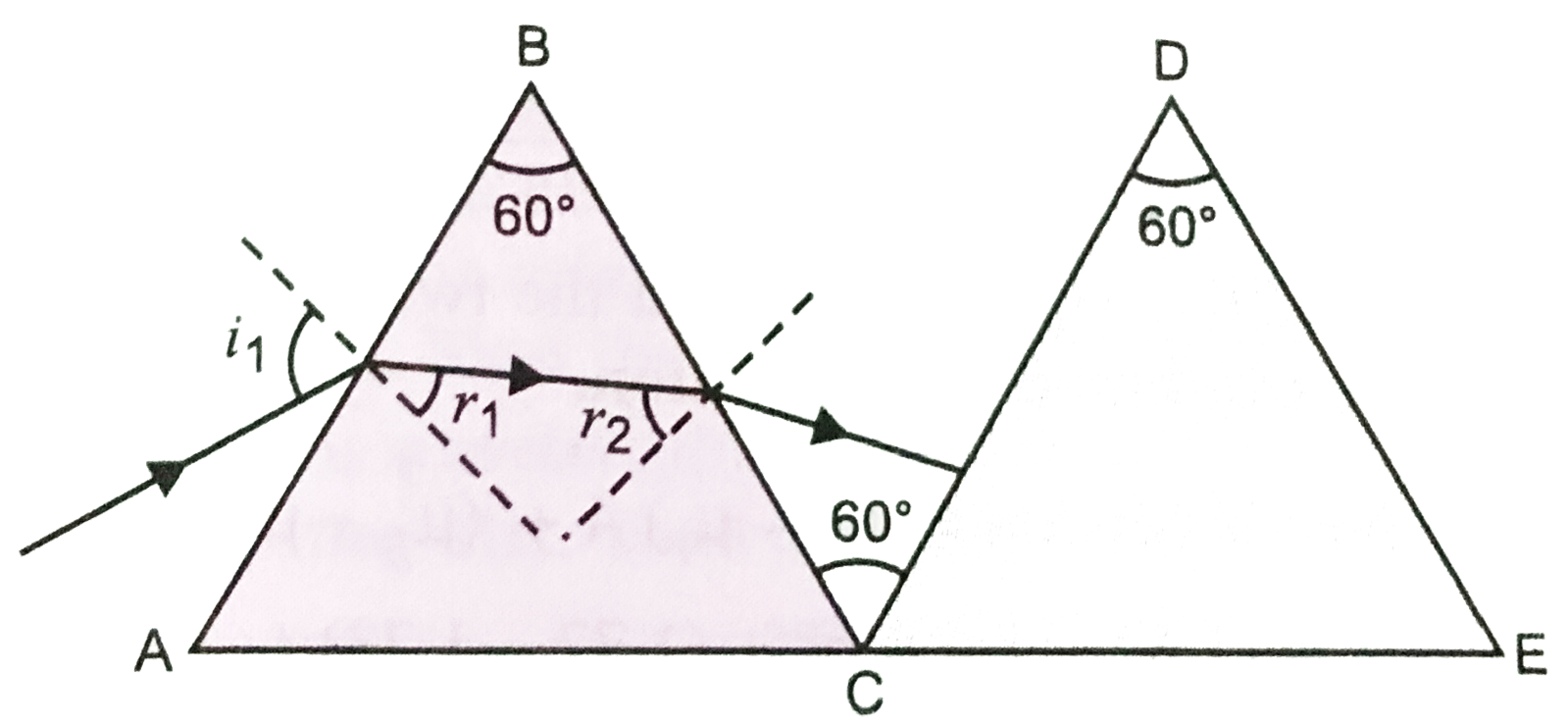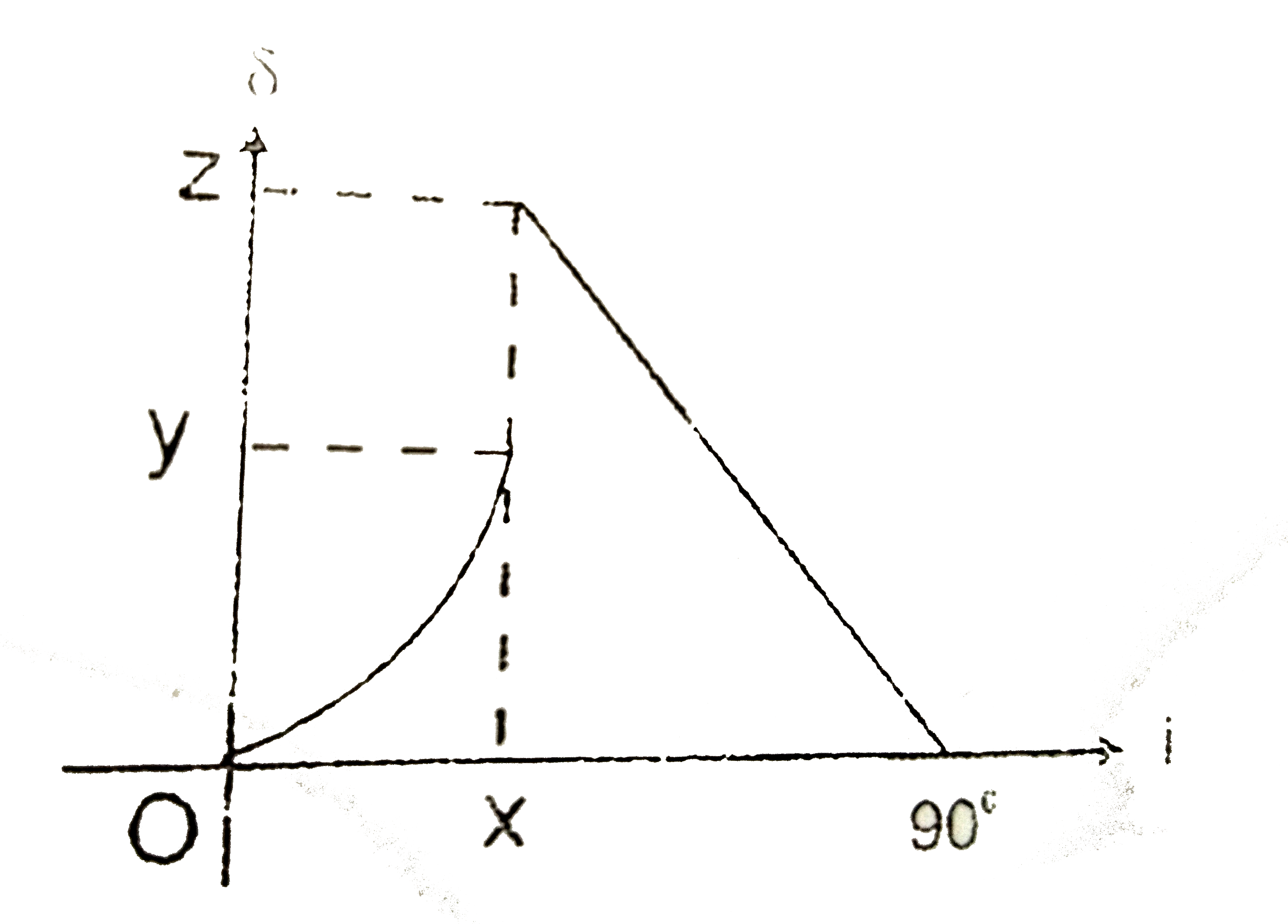Light falls from glass (μ=1.5) to air. Find the angle of incidence for which the angle of deviation is 90∘.
The correct Answer is:D
To solve the problem of finding the angle of incidence for which the angle of deviation is 90 degrees when light passes from glass (with a refractive index, µ = 1.5) to air, we can follow these steps:
1. Identify the Refractive Indices:
- The refractive index of glass (µ_glass) = 1.5
- The refractive index of air (µ_air) = 1 (approximately)
2. Calculate the Critical Angle (θ_C):
- The critical angle can be calculated using Snell's law. The formula for the critical angle is:
\sin(θ_C) = \frac{µ_{air}}{µ_{glass}} = \frac{1}{1.5} = \frac{2}{3}
- Therefore,
θC=sin−1(23)
- Using a calculator, we find:
θC≈41.8∘
3. Determine the Maximum Deviation:
- The maximum deviation occurs when the angle of incidence is equal to the critical angle. The maximum angle of deviation (D_max) in this case can be calculated as:
Dmax=90∘−θC=90∘−41.8∘=48.2∘
- However, since we are looking for a deviation of 90 degrees, we note that total internal reflection must occur.
4. Relate Deviation to Angle of Incidence:
- The angle of deviation (D) for refraction is given by:
D=180∘−2I
- For our case, we set D = 90 degrees:
90∘=180∘−2I
- Rearranging gives:
2I=180∘−90∘=90∘
- Thus,
I=90∘2=45∘
5. Conclusion:
- The angle of incidence (I) for which the angle of deviation is 90 degrees is:
I=45∘
Final Answer:
The angle of incidence for which the angle of deviation is 90 degrees is 45 degrees.
- The refractive index of glass (µ_glass) = 1.5
- The refractive index of air (µ_air) = 1 (approximately)
- The critical angle can be calculated using Snell's law. The formula for the critical angle is:
\sin(θ_C) = \frac{µ_{air}}{µ_{glass}} = \frac{1}{1.5} = \frac{2}{3}
- Therefore,
θC=sin−1(23)
- Using a calculator, we find:
θC≈41.8∘
- The maximum deviation occurs when the angle of incidence is equal to the critical angle. The maximum angle of deviation (D_max) in this case can be calculated as:
Dmax=90∘−θC=90∘−41.8∘=48.2∘
- However, since we are looking for a deviation of 90 degrees, we note that total internal reflection must occur.
- The angle of deviation (D) for refraction is given by:
D=180∘−2I
- For our case, we set D = 90 degrees:
90∘=180∘−2I
- Rearranging gives:
2I=180∘−90∘=90∘
- Thus,
I=90∘2=45∘
- The angle of incidence (I) for which the angle of deviation is 90 degrees is:
I=45∘
The angle of incidence for which the angle of deviation is 90 degrees is 45 degrees.
Topper's Solved these Questions
- GEOMETRICAL OPTICSBOOK - HC VERMA ENGLISHCHAPTER - GEOMETRICAL OPTICSEXERCISE - EXAMPLE
9 Videos
- GEOMETRICAL OPTICSBOOK - HC VERMA ENGLISHCHAPTER - GEOMETRICAL OPTICSEXERCISE - Question For short Answer
18 Videos
- GEOMETRICAL OPTICSBOOK - HC VERMA ENGLISHCHAPTER - GEOMETRICAL OPTICSEXERCISE - Objective -2
7 Videos
- GAUSS LAWBOOK - HC VERMA ENGLISHCHAPTER - GAUSS LAWEXERCISE - Short Question
7 Videos
- LIGHT WAVESBOOK - HC VERMA ENGLISHCHAPTER - LIGHT WAVESEXERCISE - Question for short Answer
11 Videos
Similar Questions
Light is incident from glass (μ=1.50) to water (μ=1.33) find the range of the angle of deviation for which there are two angles of incidence.
View SolutionA ray of light passes from glass, having a refractive index of 1.6, to air. The angle of incidence for which the angle of refraction is twice the angle of incidence is
View SolutionLight is incident from glass (μg=32) to water (μw=43). Find the range of the angle of deviation for refracted light.
View SolutionLight is incident from glass (μ=1.5) to air. Sketch thevariation of the angle of deviation δ with angle of incident i for 0<i<90∘
View SolutionA ray of light is incident on a prism ABC of μ=√3 as shown in Fig. Find the angle of incidence for which the deviation of light by the prism ABC is minimum.
By what angle should the second prism be rotated so that final ray suffers net minimum deviation ?

View SolutionLight is incident from glass to are. The variation of the angle of deviation δ with the angle of incidence i for 0<i<90∘ If the value of (x+y+z) is nπ6 then value of n.

View SolutionA ray of light falls on a glass plate of refractive index μ=1.5.
What is the angle of incidence of the ray if the angle between the reflected and
refracted rays is 90∘?
View SolutionA ray of light falls on a glass plate of refractive index μ=1.5.
What is the angle of incidence of the ray if the angle between the reflected and
refracted rays is 90∘?
View SolutionThe Brewster angle for the glass air interface is 54.74∘ if a ray of light going from air to glass strikes at an angle of incidence 45∘ then the angle of refraction is
View SolutionThe Brewster angle for the glass air interface is 54.74∘ if a ray of light going from air to glass strikes at an angle of incidence 45∘ then the angle of refraction is
View Solution
